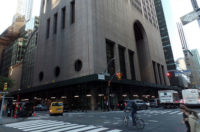UPDATED ON MARCH 2, 2018: Preservationists and architectural critics are rallying against JPMorgan Chase’s announcement last week that the bank will demolish its existing 52-story Manhattan headquarters at 270 Park Avenue to build a new 2.5 million-square-foot, 70-story tower on the site.
The bank’s CEO and chairman James Dimon explained the new headquarters would accommodate almost triple the number of employees once completed allowing the bank to stay in the city.
“We are recommitting ourselves to New York City while also ensuring that we operate in a highly efficient and world-class environment,” he said in a statement.
Originally known as the Union Carbide Building and completed in 1960, the 707-foot tower was designed by Skidmore, Owings & Merrill under design partner Gordon Bunshaft with senior design architect Natalie Griffin de Blois, once a little-known architect who is now celebrated for both her talents and playing a pioneering role as a woman in the profession. De Blois’ work on the building has become a cause célèbre for many preservationists and critics protesting 270 Park’s demolition such as Simeon Bankoff, the executive director at the Historic Districts Council.
After hearing the news, Bankoff was galvanized to renew a request — originally filed in 2013 — that the New York Landmarks Preservation Commission (LPC) designate 270 Park a New York City landmark.
The LPC confirmed receipt of Bankoff’s request, however a spokesperson told RECORD that the commission had previously considered the building and “found that other buildings from this era and architect had already been represented by landmarks” in the East Midtown area.
The spokesperson also pointed to the fact that the design of the landmarked Pepsi-Cola Building is largely attributed to de Blois. In a report for that building’s designation in 1995, LPC researchers wrote, “De Blois was fortunate to have had ‘a wonderful working relationship’ with Bunshaft, who was so busy with the Union Carbide project that she ‘was practically alone on the design work’ for the Pepsi-Cola Building.” The implication today is that de Blois was not central to the design of Union Carbide — an assessment many critics and preservationists dispute.
“It’s Natalie de Blois’ building and everyone admits it,” said Bankoff. “It was open knowledge that she was the main designer.”
But some architectural historians disagree. One of them is Nicholas Adams, who is a professor at Vassar College and is currently writing a book about Bunshaft.
To Adams, the authorship of a design is almost impossible to determine, particularly at a corporate firm like SOM where 40 people or more from various departments could work on a project.
“I myself would never say she designed the building,” he said. "It became clear the more time I spent with her that she was enmeshed in a corporate entity; she worked on the designs for Gordon Bunshaft.”
Mary McLeod, an architectural historian and professor at Columbia University’s Graduate School of Architecture, Planning and Preservation, wasn’t sure about de Blois’ contribution, but is steadfast in her support of the building’s significance.
"I don't know if Natalie de Blois was the major force in the design or not compared to Bunshaft, but, in my view, that should be irrelevant to landmark designation," she wrote in an email. "It's an amazing building and should be saved."
Like HDC’s Bankoff, Peg Breen, president of the New York Landmarks Conservancy, also wrote to the LPC last week to remind the Commission of the multi-year effort to landmark 270 Park and expressed disappointment.
“We pushed the Landmarks Commission then,” Breen said. “They didn’t complete the process. It’s a shame.”
Similar efforts are also being made by the Municipal Arts Society and Docomomo U.S.
The attempts to landmark the building began in 2012 after then-mayor Michael Bloomberg announced the upzoning of East Midtown to allow greater density and height. Organizations dedicated to preserving architectural history provided the LPC and politicians with lists of buildings worthy of landmark designation; many of those lists included 270 Park.
“This was pretty much an across-the-board recommendation,” said Kyle Johnson, a board member of the New York Tri-State chapter of Docomomo U.S.
Months later, the LPC said 270 Park “may merit designation,” and would be “further considered” alongside “the Commission’s overall priorities for the city” and its designation criteria.
In the final environmental impact statement for the rezoning plan, the city itself recognized 270 Park as an “eligible” site for landmark designation, referring to it as “one of the City’s greatest modern buildings” which “set the new standard for desirable large floor plate office structures that dominated commercial construction in Manhattan for most of the 1960s and 1970s.”
The LPC eventually designated 12 buildings within the East Midtown area months ahead of the rezoning’s passage in August 2017, and, though SOM’s 270 Park was not among them, it did not raise an alarm for preservationists at the time.
“Nobody really thought the Union Carbide Building was potentially under threat,” said Bankoff. “You’re not going to knock down a 52-story to build it up to 70.”
Johnson agreed the notion of demolition seemed “far-fetched.”
So when Bankoff opened his newspaper last week to see that was exactly what JPMorgan was doing, he was “dumbfounded.”
A recent renovation of 270 Park’s interiors achieved LEED Platinum rating in 2012, and, though the bank’s desire for additional space was clear—it considered a move to Hudson Yards in 2014—no warning bells indicated knocking down.
“No one’s ever taken down a 52-story building on purpose before,” said Bankoff. The tallest intentional demolition on record with the Council on Tall Buildings and Urban Habitat was the tearing down The Singer Building in 1969.
The demolition and rebuilding project is supported by Mayor Bill de Blasio and local politicians. If preservation efforts fail, construction on Chase’ new tower could begin as early as 2019.
NOTE: STORY WAS UPDATED ON MARCH 2, 2018 TO INCLUDE REPORTING FROM ARCHITECTURAL HISTORIANS NICHOLAS ADAMS AND MARY MCLEOD.
If you wish to sign a petition in support of preserving the former Union Carbide Building, please fill out the form below. To leave a comment, please scroll to the bottom of the page.






